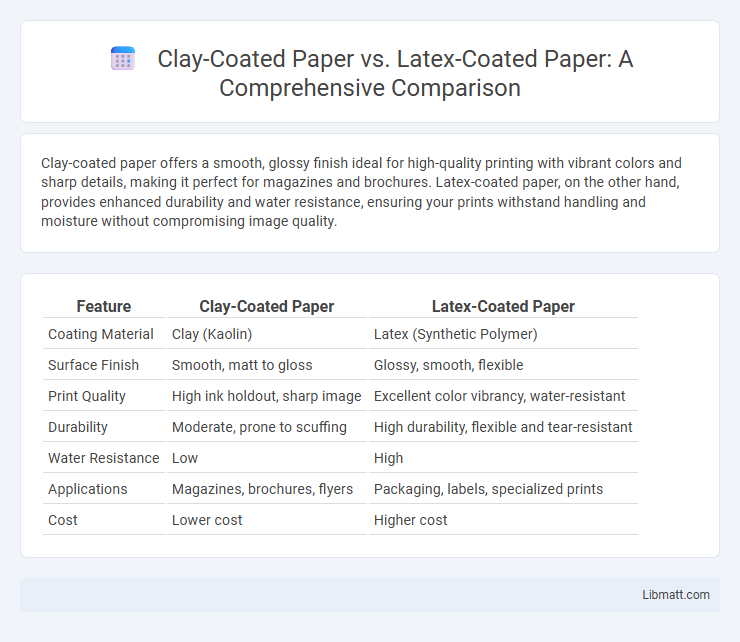Clay-coated paper offers a smooth, glossy finish ideal for high-quality printing with vibrant colors and sharp details, making it perfect for magazines and brochures. Latex-coated paper, on the other hand, provides enhanced durability and water resistance, ensuring your prints withstand handling and moisture without compromising image quality.
Table of Comparison
| Feature | Clay-Coated Paper | Latex-Coated Paper |
|---|---|---|
| Coating Material | Clay (Kaolin) | Latex (Synthetic Polymer) |
| Surface Finish | Smooth, matt to gloss | Glossy, smooth, flexible |
| Print Quality | High ink holdout, sharp image | Excellent color vibrancy, water-resistant |
| Durability | Moderate, prone to scuffing | High durability, flexible and tear-resistant |
| Water Resistance | Low | High |
| Applications | Magazines, brochures, flyers | Packaging, labels, specialized prints |
| Cost | Lower cost | Higher cost |
Introduction to Paper Coatings
Clay-coated paper features a smooth, glossy surface achieved by applying a layer of fine clay minerals, enhancing print quality and color vibrancy. Latex-coated paper incorporates a water-based polymer coating that provides durability, flexibility, and resistance to moisture and abrasion, making it ideal for high-performance printing. Both coatings improve paper aesthetics and functionality, with clay coatings optimizing visual sharpness and latex coatings emphasizing durability and resistance.
What is Clay-Coated Paper?
Clay-coated paper features a smooth, glossy finish achieved by applying a fine layer of clay to the paper surface, enhancing print quality and color vibrancy. This coating improves ink holdout and sharpness, making it ideal for high-resolution images and detailed graphics. When choosing materials, your project benefits from clay-coated paper's excellent printability and smooth texture compared to latex-coated options.
What is Latex-Coated Paper?
Latex-coated paper features a synthetic latex layer that enhances water resistance, durability, and flexibility, making it ideal for prints requiring vivid colors and sharp details. Unlike clay-coated paper, which relies on a mineral clay layer for smoothness and brightness, latex coatings provide superior tear resistance and improved adhesion for inks. This coating is commonly used in applications such as packaging, labels, and outdoor posters where longevity and print quality are essential.
Composition and Manufacturing Differences
Clay-coated paper features a surface layer composed mainly of kaolin or bentonite clay applied during the finishing process, enhancing smoothness and print quality by filling in paper pores. Latex-coated paper incorporates a polymer-based latex layer in its manufacturing, which provides improved durability, water resistance, and flexibility compared to traditional coatings. Understanding the composition differences in these coatings helps you select the right paper type for applications requiring specific print quality or environmental resilience.
Surface Properties and Print Quality
Clay-coated paper features a smooth, glossy surface with excellent ink holdout, enhancing sharpness and color vibrancy, making it ideal for high-resolution prints. Latex-coated paper offers a flexible, water-resistant surface with superior durability and scratch resistance, ensuring consistent print quality in outdoor or high-humidity environments. Both coatings improve print quality but cater to different needs--clay-coated excels in fine art and photographic prints, whereas latex-coated is preferred for signage and labels.
Durability and Resistance Features
Clay-coated paper offers excellent print quality but has limited durability and resistance to moisture and abrasion, making it less suitable for heavy handling or outdoor use. Latex-coated paper features enhanced durability with superior resistance to water, chemicals, and physical wear, ensuring your prints remain intact and vibrant under harsher conditions. Choosing latex-coated paper provides greater longevity and protection for materials exposed to frequent contact or environmental stress.
Cost Comparison
Clay-coated paper generally offers a lower cost per unit compared to latex-coated paper, making it a budget-friendly choice for high-volume printing. Latex-coated paper tends to be more expensive due to its enhanced durability and resistance to moisture, which suits specialized applications requiring long-lasting prints. Your decision should weigh the cost difference against the specific performance needs of your project to ensure optimal value.
Environmental Impact
Clay-coated paper generally has a higher environmental impact due to the non-biodegradable nature of the kaolin clay and the intensive mining process required for its production. Latex-coated paper offers better recyclability and biodegradability as natural or synthetic latex coatings can be designed to break down more effectively in recycling streams and compost environments. Choosing latex-coated paper can reduce landfill waste and lower the carbon footprint associated with paper disposal and processing.
Typical Uses and Applications
Clay-coated paper is primarily used for high-quality printing applications such as magazines, brochures, and packaging where vibrant color reproduction and a smooth finish are essential. Latex-coated paper is ideal for products requiring enhanced durability and water resistance, including labels, outdoor posters, and flexible packaging. Your choice depends on whether you prioritize print clarity or durability for the intended application.
Choosing the Right Coated Paper
Clay-coated paper offers a smooth, glossy finish ideal for high-quality image reproduction and sharp detail, making it perfect for brochures, magazines, and promotional materials. Latex-coated paper provides enhanced durability, water resistance, and flexibility, suitable for labels, packaging, and outdoor applications where longevity is essential. When choosing the right coated paper, consider the intended use, desired finish, and environmental factors to ensure your project achieves optimal performance and visual impact.
Clay-coated paper vs latex-coated paper Infographic

 libmatt.com
libmatt.com